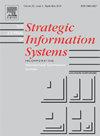包抄式数字化转型:外围代理如何转变抵抗组织
IF 11.8
2区 管理学
Q1 COMPUTER SCIENCE, INFORMATION SYSTEMS
引用次数: 0
摘要
信息系统学者长期以来一直在研究如何设计和实施信息技术(IT)系统,以实现组织的战略变革目标。这种类型的大多数研究都假定变革是从高层开始并执行的,将其他人降级为旁观者和/或变革接受者的角色。然而,考虑到最高管理层固有的保守主义以及数字化转型(DT)的破坏性和政治性,外围代理人的转型是可能的,有时甚至是必要的。据我们所知,只有少数研究考察了DT起源于外围的条件或过程,并且没有研究将这种条件理论化。为了解决这一空白,我们将这种转变理论化为一个包围圈的过程,在这个过程中,外围代理部署IT系统来发起、促进和实现被高度政治惰性阻碍的抵抗组织的DT。从瑞典一个中型城市成功的15年DT之旅的纵向研究中,归纳出了侧翼外攻的概念。该案例将城市的DT描述为一个政治过程,并利用了从多个来源(访谈、档案数据、系统文档)收集的丰富数据语料库。我们的分析表明,在包抄中,外围代理部署了三种it使用策略——屏蔽、招募和重新利用——这导致成功克服了强大而持久的政治惰性。这些令人惊讶的发现促使人们对IT作为DT过程中的一种手段所扮演的角色以及在启动、启用和实施DT过程中(外围)参与者的异质性进行更全面的理论化。考虑到分布式、灵活和强大的低成本IT解决方案的兴起,这些解决方案为外围代理提供了充分的机会来绕过核心的阻力,战术IT使用和外围代理在DT中的作用在未来可能会变得越来越重要。本文章由计算机程序翻译,如有差异,请以英文原文为准。
Digital transformation by outflanking: How peripheral agents transform resisting organizations
Information systems scholars have long investigated how to design and implement Information Technology (IT) systems that realize organizations’ strategic, transformative goals. Most studies of this kind posit that transformation originates and is executed from the top, relegating others to the role of bystanders and/or recipients of the change. However, transformation by peripheral agents is possible and sometimes even necessary, given the inherent conservativism of top management and the disruptive and political nature of Digital Transformation (DT). To our knowledge, only few studies have examined the conditions or processes whereby DT originates from the periphery, and no study has theorized such conditions. To address this void, we theorize such transformation as a process of outflanking wherein peripheral agents deploy IT systems to initiate, promote, and actualize the DT of a resisting organization encumbered by high political inertia. The concept of outflanking is inductively inferred from the longitudinal study of a successful 15-year DT journey experienced by a mid-sized Swedish city. The case narrates the city’s DT as a political process and draws on a rich data corpus collected from multiple sources (interviews, archival data, system documentation). Our analysis reveals that during outflanking, peripheral agents deployed three IT-use tactics—shielding, enrolling, and repurposing—which led to successfully overcoming the strong and persistent political inertia. The surprising findings invite a fuller theorizing of the roles IT can play as a means during DT and the (peripheral) actor heterogeneity in initiating, enabling, and effectuating DT. Given the rise of distributed, flexible, and powerful low-cost IT solutions that offer peripheral agents ample opportunity to outflank the core’s resistance, tactical IT use and peripheral agents’ role in DT will likely grow in significance in the future.
求助全文
通过发布文献求助,成功后即可免费获取论文全文。
去求助
来源期刊

Journal of Strategic Information Systems
工程技术-计算机:信息系统
CiteScore
17.40
自引率
4.30%
发文量
19
审稿时长
>12 weeks
期刊介绍:
The Journal of Strategic Information Systems focuses on the strategic management, business and organizational issues associated with the introduction and utilization of information systems, and considers these issues in a global context. The emphasis is on the incorporation of IT into organizations'' strategic thinking, strategy alignment, organizational arrangements and management of change issues.
 求助内容:
求助内容: 应助结果提醒方式:
应助结果提醒方式:


